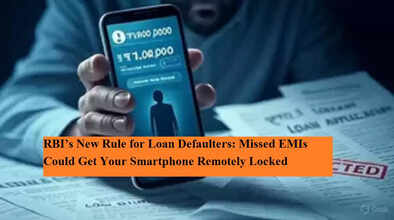RBI’s New Rule for Loan Defaulters: Missed EMIs Could Get Your Smartphone Remotely Locked

If you purchased a smartphone on EMI and haven’t been paying your installments on time, it’s time to be cautious. Under the Reserve Bank of India’s (RBI) latest directives, banks and non-banking financial companies (NBFCs) may soon have the authority to remotely lock smartphones of loan defaulters.
This unprecedented move aims to curb rising loan defaults and instill financial discipline among borrowers. But it also means that your smartphone—an essential part of everyday life—could turn into a useless device if you ignore your EMIs.
What Does the New RBI-Backed Plan Mean?
-
Many digital loan apps and financing companies are now embedding tracking and lock features in smartphones purchased on EMI.
-
If a customer fails to pay their installment for 90 consecutive days, the lending institution can remotely trigger a lock on the phone.
-
Once locked, the phone becomes non-functional—you won’t be able to make calls, use apps, or even access basic features.
This system is being pitched as a deterrent to discourage people from missing payments and to reduce the growing risk of unsecured lending in India.
Why Is RBI Supporting This Move?
The rise of digital lending platforms has made consumer loans easily accessible. While this has boosted financial inclusion, it has also led to a spike in loan defaults.
-
For lenders, smartphones are not just a product but also collateral when given on EMI.
-
By enabling a remote lock mechanism, lenders gain more control over repayment compliance.
-
RBI sees this as a way to balance borrower freedom with lender security, especially in the consumer electronics segment where defaults are rising.
How Will Remote Locking Work?
-
Purchase & Agreement – When you buy a phone on EMI, the loan agreement will clearly mention that the device may be locked in case of default.
-
Tracking Software – The phone will have pre-installed apps or digital tags that allow lenders to monitor EMI payments.
-
Default Trigger – If payments are not made for 90 days, the system will automatically send alerts. After repeated reminders, the lender can activate the lock remotely.
-
Unlock After Payment – Once dues are cleared, the lender can reactivate the device and restore normal usage.
Impact on Borrowers
This policy is expected to change consumer behavior significantly. For borrowers:
-
Higher Risk of Losing Access – Your phone, which you use for banking, work, and daily communication, may stop functioning.
-
Mental Stress – Having your device locked can add to financial and emotional stress.
-
Serious Reminder – It serves as a strict reminder that EMIs are non-negotiable.
For lenders, this provides an additional layer of security and reduces the chances of non-recovery.
Why Timely EMI Payment Matters More Than Ever
Ignoring EMI payments will no longer just mean late fees or a drop in your credit score. With this system in place:
-
Your smartphone could be disabled.
-
Your credit score will still take a hit, making it difficult to secure future loans or credit cards.
-
Penalty charges and legal notices could add further financial burden.
Thus, managing your EMIs responsibly is now more crucial than ever.
Final Takeaway
The RBI-backed remote phone lock mechanism marks a new era of strict lending practices in India. For borrowers, this means that financial discipline is no longer optional—defaulting on EMIs can directly impact daily life.
If you’ve taken a smartphone on EMI, make sure you pay your dues on time. Otherwise, your most essential gadget could be reduced to nothing more than a paperweight.

